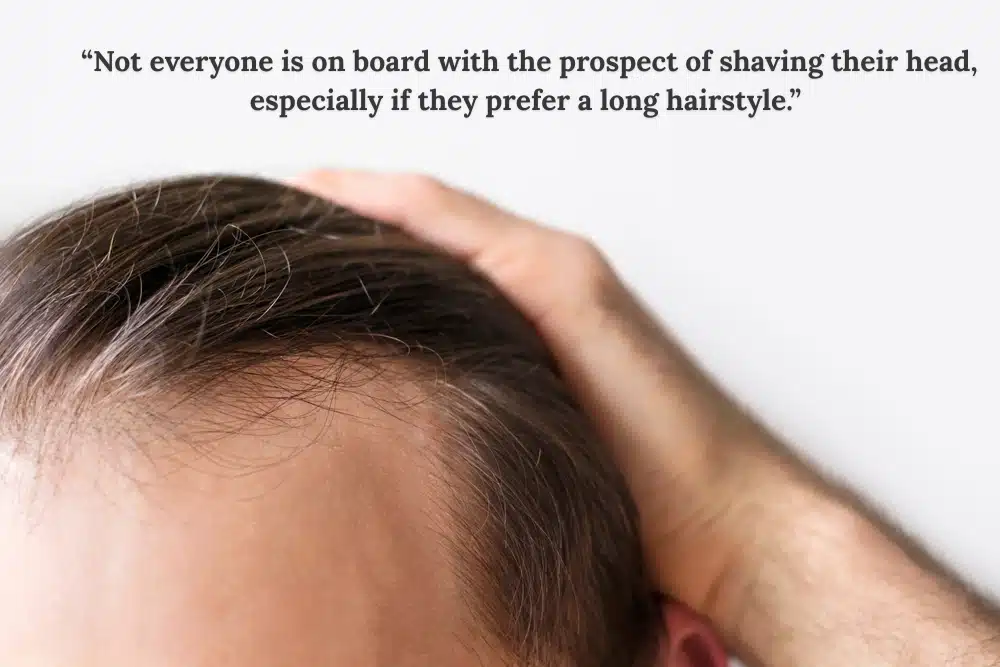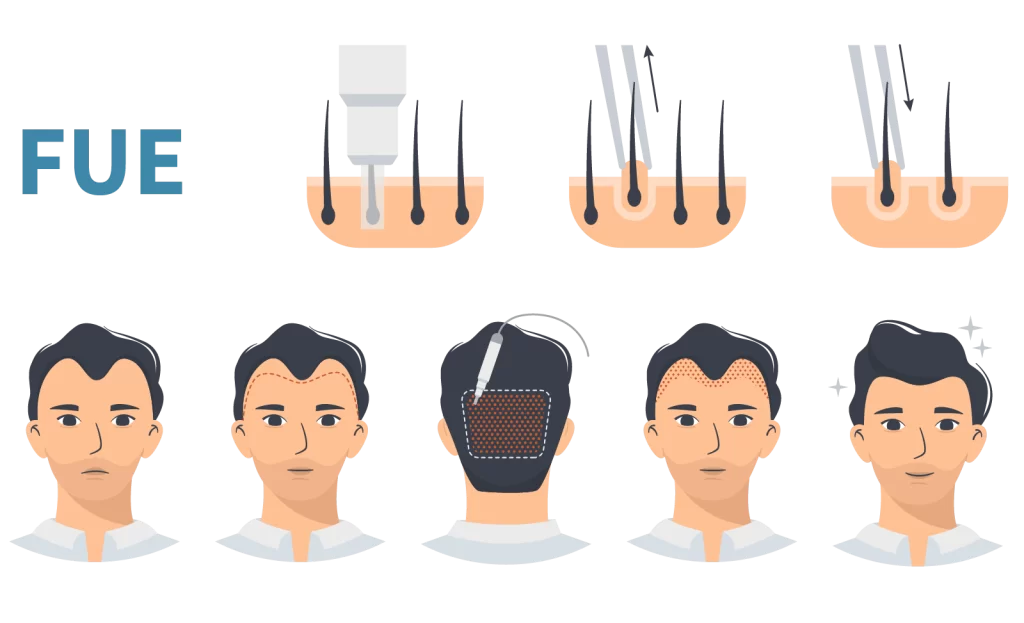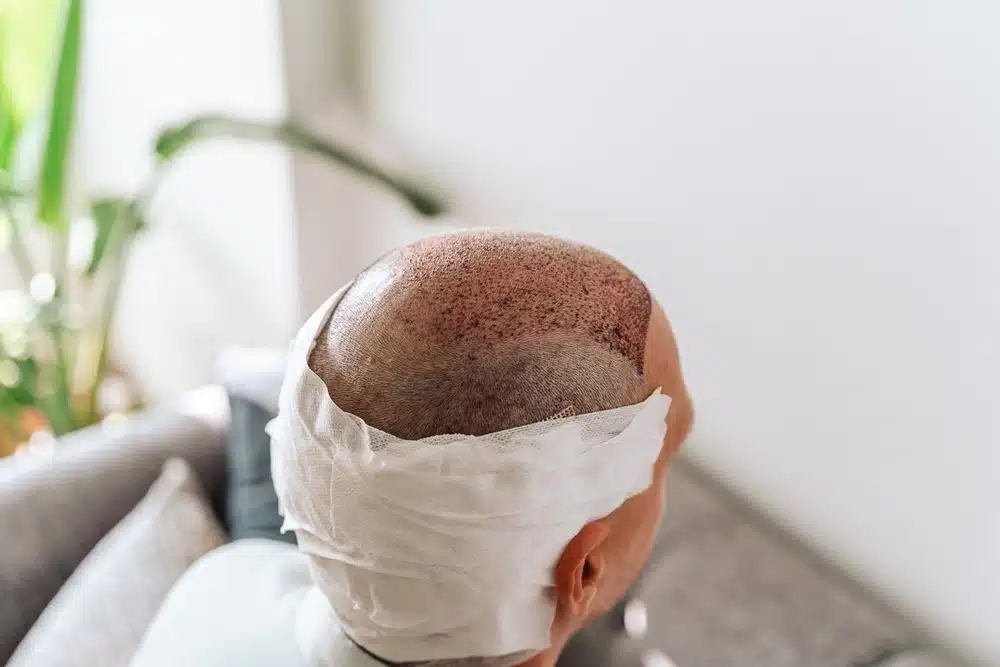When undergoing a typical hair transplant, the process involves the surgeon shaving a section of your head to gain easy access to the hair follicles. It works well for many, especially those who already have short or cropped hair. However, not everyone is on board with the prospect of shaving their head, especially if they prefer a long hairstyle. That is where an unshaven FUE hair transplant comes in.
Understanding FUE Hair Transplants: How They Work
Before diving into unshaven FUE, let’s get to know how FUE works.
FUE (follicular unit extraction) is a specific type of hair transplant that provides natural results, and it accomplishes this through precision. The surgeon begins by shaving the donor area in order to gain access to the follicles. The surgeon extracts individual hair follicles from the donor area, which is usually the back of the head or the sides of the scalp, and then implants them into the recipient sites. Once the hair has been transplanted, new hairs begin to grow, leading to fuller hair once more.
What is an Unshaven FUE Hair Transplant?
An unshaven FUE hair transplant uses many of the same hair transplant techniques as a regular FUE transplant. The main difference is that the surgeon does not shave the head or only shaves a very small amount (known as partial shaving).
By doing this, the transplant is much more discreet and allows you to keep your hair’s length while also receiving new hair growth.
The Benefits of an Unshaven FUE Transplant
Are you wondering whether an unshaven FUE hair transplant is the best option? Here are some of the undeniable benefits.
Discretion
One of the main reasons people choose an unshaven FUE hair transplant is its discretion. After a traditional hair transplant surgery, it’s usually quite visually obvious that a person has undergone the surgery, as the head is suddenly shaven and there are initial markings (that later heal). However, with UFUE hair transplants, the healing area of the scalp is hidden by the hairs.
Maintains Hairstyle
Sudden and drastic changes to your hairstyle can be overwhelming, and many people want to avoid them, even when they undergo a hair transplant. With an unshaven FUE transplant, individuals can maintain their style and length while still enjoying the results of the transplant. So, if a person has very long hair, they don’t have to lose all of their length.
A Natural Result Straight Away
FUE hair transplants are great as they provide natural results. The only drawback here is that it takes a few months for these natural results to fully show through when the first hairs begin to grow. That’s not the case with an unshaven hair transplant, as the longer hair can cover the healing area, meaning the results look natural from the very first day.
The Drawbacks of an Unshaven FUE Transplant
While there are plenty of benefits to the unshaven hair transplant procedure, there are also some drawbacks that may put you off getting on.
A More Complicated Surgical Process
One downside to the unshaven hair transplant is that it is a more complicated process overall. It requires a highly qualified and skilled hair transplant surgeon who knows how to work with longer hair. As a result, the surgery itself takes longer.
Infection Risk
With an unshaven hair transplant, there is, unfortunately, an increased risk of infection. Hair transplant infections are quite rare, especially when the surgery is performed by a qualified hair transplant surgeon. However, an unshaven transplant makes this slightly more likely as there isn’t as easy access to the transplanted hair area.
It should be noted that hair transplant infections are rare (occurring in under 1% of cases). [1] Still, it’s important to know the symptoms, including red skin, pain, and fever.
A Higher Cost
Hair transplants are already quite expensive (the results are typically permanent, after all). An unshaven hair transplant only increases this cost, which can be a major downside to those wanting a more affordable hair loss treatment. The surgery is more complicated and requires more skill and time from the surgeon, which means an overall higher cost per graft compared to a more traditional surgery. Additionally, multiple sessions may be required, which can further increase the price.
It Is Not Suitable for Excessive Hair Loss
While an unshaven hair transplant can work well for this with minimal hair loss, it typically is not the best option for those with more extensive hair fallout. That’s because the process of an unshaven hair transplant does not typically lead to a high level of density. While this can be suitable for those with slight thinning, it may not be the best option for those seeking a comprehensive hair transformation, as it requires a higher number of hair grafts.
More Intensive Aftercare
Every person who undergoes hair transplant surgery, whether shaven or unshaven, must follow aftercare instructions. It is simply part of the process. However, one drawback for the unshaven option is that aftercare tends to look a little more complicated, or at least more involved. It isn’t as easy to look after the healing section if other hairs are covering the area, after all.
Results May Not Be as Natural
While an unshaven hair transplant can give excellent results (assuming you choose a high-quality clinic), be aware that, sometimes, this option can cause less natural results overall. That is because the surgeon does not have as easy access to the existing hairs in the donor or recipient area. Due to this, they may not be able to perform precise surgical incisions.
Should You Get an Unshaven Hair Transplant? What to Consider
Are you considering opting for an unshaven hair transplant? If you want to avoid shaving your head and exposing an obvious recipient area, this may be a good option. However, there are some things to consider first.
The Extent of Your Hair Loss
The extent of your hair loss should determine the type of hair transplant you get. If your hair loss is minimal, an unshaven hair transplant may be an option. On the other hand, if you have extensive hair loss, you may need a more traditional FUE transplant that involves a fully shaved head.
Your Choice of Surgeon
The surgeon you choose plays a significant role in how natural your results look. If you really want an unshaven hair transplant, it’s best to pick a surgeon who has experience with this particular kind of hair transplant – preferably with photos and other evidence of positive testimonials. If you want to speak to professional hair transplant surgeons in the UK, download our Hair Track App.
Your Budget
As mentioned, an unshaven hair transplant is typically more expensive than a traditional FUE transplant as it’s more complicated. So, factor in your budget when deciding whether an unshaven transplant is right for you – if you are on a tighter budget, you may not want to pay the premium of an unshaven procedure.
Your Expectations
Finally, consider your expectations. Do you want a lot of new hair density? If that’s the case, you may need a traditional hair transplant. Are you more focused on achieving a discreet aesthetical appearance directly following the surgery? If so, an unshaven procedure is likely the best option for you.
Of course, it’s always best to speak directly to a hair transplant expert before making the final decision.
What About Other Types of Hair Transplants?
It’s worth learning about some of the other types of hair transplants available, as you may find another one that suits you and your hair type better.
DHI: DHI (direct hair implantation) is a specialised type of hair transplant that uses the Choi Implanter Pen. This creates a more seamless, streamlined hair transplant process, as this pen provides absolute control over the angle and depth of the follicles.
FUT: FUT stands for follicular unit transplantation. This is a hair transplant that uses a strip method – essentially, the surgeon grafts a strip of skin with the hair follicles on at once. This option creates a more noticeable scar at the donor site but can be a good choice for those who require a large number of grafts.
Unshaven FUE Hair Transplant: Final Thoughts
A traditional hair transplant requires a shaved head, which can put some people off this procedure. The unshaven FUE hair transplant method allows you to maintain your hair’s length and style while regaining a full head of hair. Keep in mind, though, that an unshaven FUE hair transplant does have its drawbacks as it’s a more complicated surgery.
Are you interested in restoring your locks? Here at Harley Street Hair Clinic, we offer an unshaven FUE hair transplant UK, so you can regrow a full head of hair while maintaining a natural look. Get in touch today or go to our patients gallery to see the results we provide.
Sources:
- https://www.medicalnewstoday.com/articles/infected-hair-plugs





